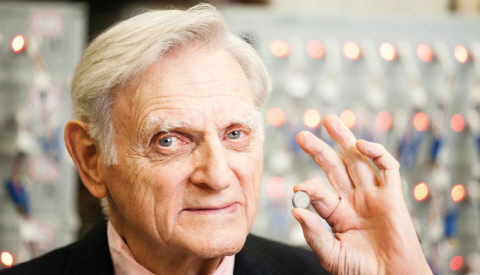
   |
[Headlines] (HL-과학/기술/교육) US Inventor’s Battery Could Change the World... Again
최고관리자 | 17-05-07 13:42

American inventor John Goodenough first started working on battery technology more than 40 years ago. Goodenough actually co-invented lithium-ion batteries in 1980. This eventually led to a revolution in the electronics industry because those devices were smaller and provided more electricity than other fuel cells. Sony Corporation was the first business to commercially develop the lithium-ion technology. In 1991, Sony launched worldwide sales of lithium-ion batteries. They enabled the company to start producing small video cameras and other devices that soon became very popular. The same technology is still used today to power most personal devices. Now, John Goodenough is 94-years-old. He continues working as an engineering professor at the University of Texas in Austin. Goodenough recently announced what he believes is another major development in battery technology. He and his engineering team have produced the first-ever solid-state battery cells. He hopes this latest invention will shake up the electronics world.
* lithium-ion battery = 리튬이온 전지(보통 전지보다 오래 사용)/ eventually = 결국, 궁국[최종]적으로/ lead to ~ = ~로 이어지다/ revolution = (사회 제도・조직 등의) 혁명[변혁]/ electronics industry = 전자 산업/ fuel cell = 연료 전지/ commercially = 상업적으로, 영리적으로/ shake up ~ = ~을 대대적으로 개편하다
Researchers say the new, solid-state batteries can hold more power, charge faster, and do not get as hot as ones currently in use. They have at least three times as much energy density as today’s lithium-ion batteries, notes Goodenough. He said the main difference between the old and new technology is that the latest battery cells use parts made of glass, instead of liquid. “I was trying to improve the lithium-ion battery that you use in your cell telephone that has several problems,” Goodenough said, explaining how he made the discovery. He said a big problem with liquid parts is they can catch fire under some conditions. John Goodenough said his latest discovery also has the possibility to solve many other problems with current batteries. These include cost, energy density, rates of charge and discharge and battery life. While his first invention helped start a wireless revolution, he hopes the latest one will help support many forms of sustainable energy. The goal is to use the new batteries to store energy produced by renewable sources, such as the sun and wind. This energy could then be used to run electric vehicles or to provide power for homes.
* charge = 충전하다/ in use = 사용되고 있는/ energy density = 에너지 밀도/ catch fire = 불붙다, 타오르다/ battery life = 배터리 수명/ sustainable energy = (환경 파괴 없이) 지속 가능 에너지
   |




